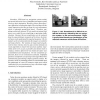Free Online Productivity Tools
i2Speak
i2Symbol
i2OCR
iTex2Img
iWeb2Print
iWeb2Shot
i2Type
iPdf2Split
iPdf2Merge
i2Bopomofo
i2Arabic
i2Style
i2Image
i2PDF
iLatex2Rtf
Sci2ools
103
Voted
CVPR
2006
IEEE
2006
IEEE
Fast Compact City Modeling for Navigation Pre-Visualization
Nowadays, GPS-based car navigation systems mainly use speech and aerial views of simplified road maps to guide drivers to their destination. However, drivers often experience difficulties in linking the simple 2D aerial map with the visual impression that they get from the real environment, which is inherently ground-level based. Therefore, supplying realistically textured 3D city models at ground-level proves very useful for pre-visualizing an upcoming traffic situation. Because this pre-visualization can be rendered from the expected future viewpoints of the driver, the latter will more easily understand the required maneuver. 3D city models can be reconstructed from the imagery recorded by surveying vehicles. The vastness of image material gathered by these vehicles, however, puts extreme demands on vision algorithms to ensure their practical usability. Algorithms need to be as fast as possible and should result in compact, memory efficient 3D city models for future ease of dis...
Related Content
| Added | 10 Jun 2010 |
| Updated | 10 Jun 2010 |
| Type | Conference |
| Year | 2006 |
| Where | CVPR |
| Authors | Nico Cornelis, Kurt Cornelis, Luc J. Van Gool |
Comments (0)

